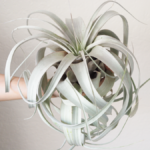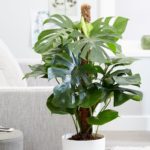The Houseplant Utopia
Our world has been progressing indoors. We’ve gone from ancestors who’ve farmed, living in small huts and communicating with a person no further than three miles away, to the present work of desk jobs, never-ending emails and worldwide communication of plants. Even as I type this article now, I’ve been in contact with plant suppliers from Holland to Africa and Japan and in between. While our world continues to change, our shared love of plants has not.
Like us, plants have not only stayed outdoors, but have slowly progressed their way inside. Point in fact, the 23 plants currently lining my apartment window. If I can’t be outdoors, then I must bring the outdoors in.
As the business manager for tropical and foliage plants, I’ve just started my dive into the wonderful world of indoor plants. And let me tell you, it’s a jungle out there.
Between ‘Pink Princess’ philodendron cuttings selling for over $250 and Brown ZZ plants replacing the normal green, it’s the tropical and foliage Wild West. Here are three reasons why you should grab your cowboy boots, buckle down and join the frenzy of indoor #plantparents.
MILLENNIALS AND GEN X
We’ve seen a huge growth in the new “plant parents” market. With millennials (Note: Although I’m not overly fond of the term, it does help narrow a group of people. For all the millennials out there, we can cringe together), urban apartments are on the rise. Combine that with environmental conscious passions and people’s newfound awareness for plants, indoor plants are booming.
Indoor plants are the “Gateway to Gardening” drug. One houseplant leads to two, which leads to three, which eventually leads to #plantparents with over 100 plants to take care of. According to the National Gardening Association, “Houseplant sales have increased 50% in the last three years.” For plant parents, these plants offer meaning and fulfillment with commitments that are not as intense as pet ownership. My plants will survive a week when I work out of town; my dog would need a caregiver.
KEY VARIETIES
The true plant parents are looking for the weird, unusual, uniquely different plants not found in every household. Monsteras, philodendrons, caleathas and String of Dolphin are on the rise. A running joke with most Florida suppliers is that “string of anything” will fly right off the shelves. They’re looking for tags with the plant’s Latin name or “one-of-a-kind” plant auctions held in the warehouses of Miami.

Many of the new plant buyers have never purchased many houseplant staples. Pilea and peperomia have continued to rank high on indoor plant charts, with their pancake-shaped leaves and unassuming demeanor. Spider plants have been creeping their way through apartments, setting up homes on bedroom nightstands or kitchen windows. Tillandsia — air plants — are dropping from ceilings in Macramé hanging baskets. My own Tillandsia xerographica currently sits in my kitchen sink soaking up the faucet mist.
For both parties, the key is to be unique. Variegation and new color combinations of current staple plants are becoming hot. Now let’s bring forth BIG. Robust and majestic houseplants are filling up magazine spreads and movie sets. There is a market for new variations of houseplants. I think the biggest opportunity is for new unique varieties of the staple options since growers can still grow the old faithfuls and make money.
MARKET POTENTIAL
Although I am no wolf on Wall Street, I truly think the houseplant trend will continue to expand. Foliage plants are at their all-time high, with data suggesting millennials are the biggest generation to purchase houseplants.
Why is this? Let’s take a look at what we — as millennials — are doing.
People are staying in urban areas and waiting to have families of their own. We’ve traded our own flesh-and-bone kids for furry babies and high maintenance plants. And, just like your own kids, I don’t believe this attachment will fade away anytime soon.

Take a gander at social media platforms like Instagram and Pinterest. These picture-based platforms push the trend by making interesting plants visible to the masses sooner and social media is not going away anytime soon. The connections people are creating with similar #plantparent interests broadens our community reach and creates a trend that will not fall to the wayside.
JOIN THE WILD WEST
Grab your best cowboy boots and throw your hat into the ring. Delve into an expanding market just waiting for new plants, unique cuttings, and old-fashioned houseplant love. Even though our world is constantly changing, our shared love of plants will not.


 Video Library
Video Library 




















